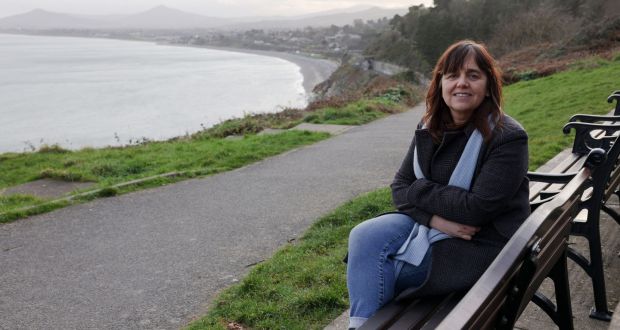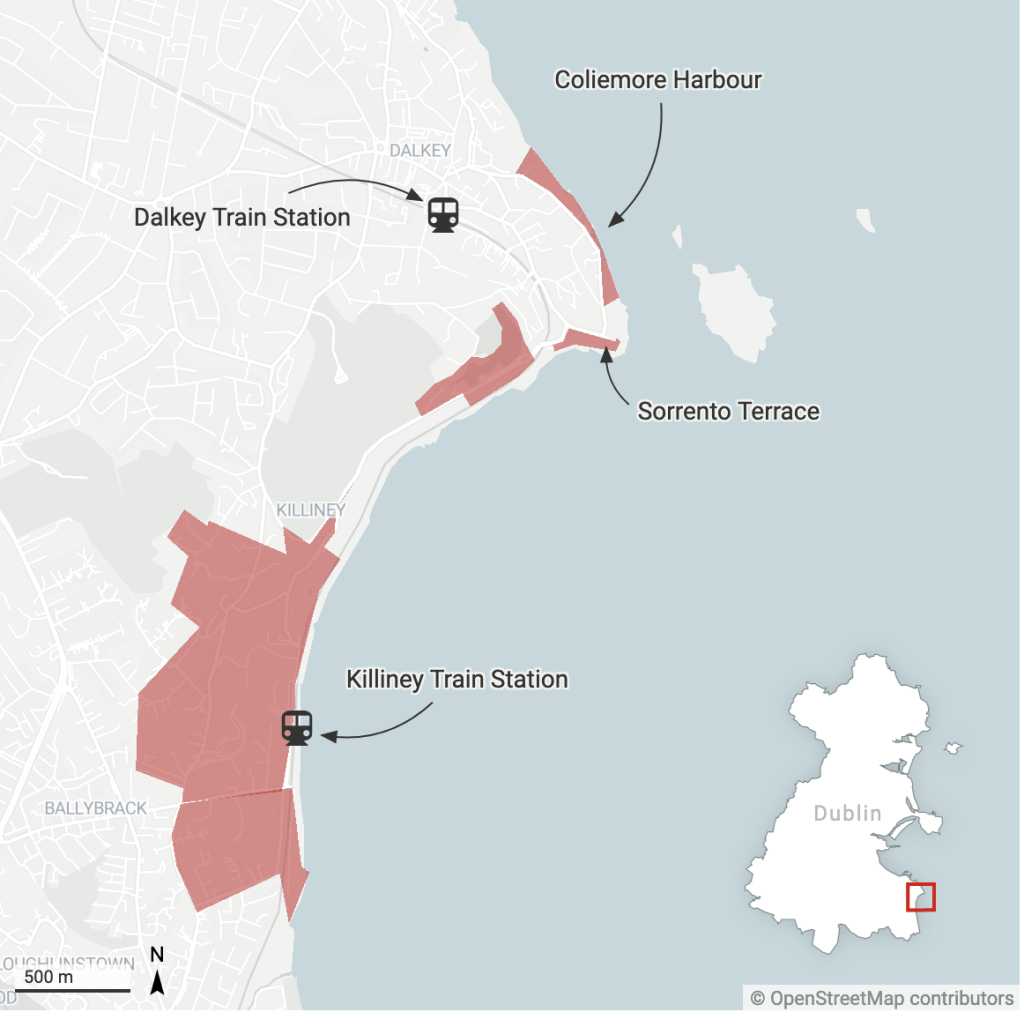Killiney planning: ‘There is no way housing built on that strip of land would help solve the crisis’

There is a steady stream of walkers and cars passing along Vico Road, Ireland’s answer to Italy’s Amalfi Coast, on an overcast but pleasant afternoon on Wednesday.
People stop to investigate and natter about construction work on one house on the Killiney Hill side, curious to know what someone could be building here. Not much happens on this seaside thoroughfare between Dalkey and Killiney in south Co Dublin without people taking notice.
On the other side, businessman Ian Curley is sitting on a park bench at the top of the walk down to White Rock beach below, busy chatting on his phone and watching his dogs.
Curley, a former top executive at packaging giant Smurfit and glass maker Ardagh, points down Vico Road towards Dalkey to the building site and a crane, a rare sight on this road. It is his knockdown-refurbishment where he is replacing one multimillion-euro mansion with another.
This area has some of Ireland’s most expensive Eircodes. It is home to the wealthy and the famous. Bono and Enya all have homes a stone’s throw away.
Curley bought the house in 2015. He secured planning for his new home in 2018 over plenty of objections after An Bord Pleanála rejected an appeal by Dalkey Community Council against the original permission granted by Dún Laoghaire-Rathdown County Council.
His project is an example of how difficult it is to secure planning permission around here, even for single homes. Given the price of local land, developers looking to construct multiple homes on single sites have to build up and price up in order to guarantee a return.
In October, councillors voted to block any development with multiple homes on lands along this coastal route, from Dalkey to Killiney
For them, planning may become easier if the Planning Regulator has his way. The regulator has so far over-ruled county development plans in only a handful of cases but it has taken issue with councillors here in Dún Laoghaire Rathdown on their draft development plan, which will cover planning on Co Dublin’s southeast coast for the next six years.
The regulator takes a helicopter view of Ireland’s planning system – local authority by local authority – to ensure they are planning in a way that is consistent with national legislation and policy. The function, born out of the Mahon tribunal – the long-running inquiry that unearthed systemic corruption in Dublin’s planning system – is effectively to put manners on planners.
In October, councillors voted to block any development with multiple homes on lands along this coastal route, from Dalkey to Killiney, that incorporates lands south of Dalkey village and east of Killiney Hill down to the area along the coast around Killiney Dart Station.
Zero-zero zoning
The objective of the so-called zero-zero zoning is to protect the heritage and character of this area with its period homes, winding roads and mature, walled gardens. It prevents “an increase in the number of buildings permitted” on any site under this zoning.
The regulator sees things differently, especially given the local Dart service. According to the National Planning Framework, lands close to “high capacity public transport routes” are perfect for “compact growth and sustainable urban development”.
Objective Areas
The zero-zero zoning area in the proposed Dún Laoghaire-Rathdown County Development Plan 2022-2028 where no increase in the number of buildings will be permitted.

The planning watchdog argues that the “zero-zero zoning” ban is “not consistent with providing homes for people in well-serviced areas”. While appreciating “the desire to protect these areas from unacceptable forms of development”, the regulator has said that the heritage and amenity of the area is already protected as an “architectural conservation area” and with other controls set out in the draft plan.
Councillors had already overruled the council’s chief executive who, in July, considered the zero-zero zoning “contradictory” as it implied that “no new development can be accommodated, whereas in fact sensitive infill can be considered subject to the policies of the plan”.
The regulator could yet issue a notice to the Minister for Local Government and Planning recommending a direction to compel the local authority to remove the zero-zero zoning.
Interestingly, Melisa Halpin, a People Before Profit councillor who voted for the measure, resents the interference of authorities overriding “what has been democratically debated”.
She argues that the regulator issuing directives makes “a mockery” of one of the few roles councillors have: drafting a county development plan in close consultation with the public.
“The process goes on for about two years, and the public gets to submit at every level, but then, late in the day, along comes Mr Planning Regulator and says: you can’t be doing that,” she says.
“There is no way that any housing built on any of that strip of land would help solve the housing crisis”
A member of a party of the left, she is keen to stress she is not looking out for the wealthy of Dalkey and Killiney but wants to preserve a coastal area of great amenity for the public.
“Any private development and housing would essentially be a privatisation of that area and it would ultimately block off access,” she says.
“There is no way that any housing built on any of that strip of land would help solve the housing crisis. They would be utterly unaffordable to those on low and middle incomes who are seeking to buy houses in this area. They would be really stratospheric in price.”
Matt Damon effect
A short distance up the coast, Dr Susan McDonnell, spokeswoman for Dalkey Community Council, points to “Matt Damon arriving” during Covid-19 and the viral effect his outdoor activities during his Dalkey lockdown had in drawing attention to the district’s amenities People discovered the beauty of this part of the county because they could not travel farther.
“There has never been so much footfall here as in the last two years,” says McDonnell. “That is people coming from all around the county. It has just been unbelievable.”
She objects to the one-size-fits-all approach guided by the National Planning Framework when there should be greater flexibility for areas such as Dalkey, which, she argues, is not suited to larger developments.
“Part of the charm is the small roads, the trees, the sea – all that kind of natural amenity. If we have these large developments, all that goes. The very thing that attracts people is taken away.”
Sitting on a bench at Bulloch Harbour in Dalkey, a small working harbour outside the zero-zero zoning area, McDonnell points to the site where she and other locals are objecting to what she calls a “Costa del Sol-looking” mixed scheme that includes three three-storey houses. She believes similar developments could spring up elsewhere if the no-building zoning is removed.
“They are not going to solve the housing crisis with this,” she says, pointing to the proposed development for the derelict ship chandler’s building at the harbour.
Fine Gael councillor for Killiney-Shankill Jim Gildea does not disagree with government policy to build compact sustainable development along corridors of public transport but thinks the regulator is not taking account of the specific make-up of this area.
“In the entire area under the zero-zero zoning I don’t think there is a single spot you could get in a development of 40 or 50 units. I don’t think there is enough flat ground,” he says.
“Why is it okay for Shankill and not for the likes of Dalkey and Killiney? There is no reason why Dalkey cannot have social and affordable housing”
Around Dalkey, there are different views among the dog-walking locals.
One woman, who has a son living at home on minimum wage and cannot afford rent in a place of his own, questions why even some social and affordable housing cannot be considered for Dalkey when the council is developing 600 such homes on the coast at Shanganagh in Shankill.
“That is right on the beach. Why is it okay for Shankill and not for the likes of Dalkey and Killiney? There is no reason why Dalkey cannot have social and affordable housing,” she says.
But, like Gildea, she agrees Dalkey has a scarcity of suitable sites.
“I don’t know where the land is,” she says.
Source The Irish Times







